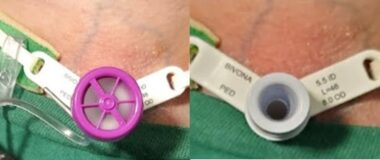Training my home-care nurses is key to preventing emergencies

First in a series.
As someone with SMA, I often think about the safety of my care. Many years ago, I told someone I’d been busy training a new nurse, and the person I was talking to responded, “Ari, you made me laugh out loud!”
What was so funny about what I said? Most people don’t know all the factors involved in home healthcare, so perhaps that person assumed any nurse could walk into my home and instantly know how to take care of me.
But there are many reasons why this isn’t the case. One major reason is that regardless of whether care is provided at someone’s home or a medical facility, every patient is different. We each have small but crucial details that make up our care. If a nurse isn’t trained to catch these small details, a life-threatening situation can quickly arise.
How the Passy Muir Valve works
One such detail I train my home-care nurses to do is taking off my Passy Muir Valve (PMV) at the right time. This small, lightweight medical device can be placed on the opening, or “hub,” of my tracheostomy tube, where it “redirects airflow through the vocal folds, mouth, and nose, enabling voice and improved communication,” the Passy Muir website notes.
The PMV enables me to talk with my real voice when I’m not using my TD I-Series computerized voice device.

Ari Anderson’s tracheostomy with his purple Passy Muir Valve on (left image) and off. (Courtesy of Ari Anderson)
I wear the PMV whenever I’m sitting in my chair, whether I’m talking with my regular voice or my computerized voice. Usually, when I’m seated, my neck and back are straight. This allows the PMV to redirect air upward like it’s supposed to, and I can exhale through my mouth when I breathe.
Using it safely
However, if my head or neck is bent forward while the PMV is on, air can no longer move freely upward. With my upper airway blocked, I’m unable to exhale when I try to breathe out through my mouth.
It’s OK for me to leave the PMV on when I adjust myself with my chair controls, as this doesn’t move my neck that much. But there are times when my neck is bent forward while my nurses are performing medical care activities. If they were to leave the PMV on during these times, it could quickly turn into a crisis.
To prevent an emergency, a nurse simply has to take the PMV off the opening of my trach until my neck and body are straight enough to have it back on. This action takes only a second, but it can save my life. Taking the PMV off allows me to bypass my upper airway when it’s blocked. Instead, I can breathe out through the opening of my tracheostomy rather than through my mouth. Nurses often turn my ventilator on when my PMV is off.
One situation where a nurse always needs to take the PMV off is when I’m being transferred with the ceiling lift, due to the position of my neck. Also, my nurses must be extra careful with my positioning when I’m sick.
In my experience, many nurses don’t know much about the Passy Muir Valve. I have a lot of gratitude when my agency sends out nurses who are willing to learn about this device and other things they hadn’t been exposed to before meeting me.
I do face serious risks if people aren’t careful with my care. Training home-care nurses on my case is no laughing matter. However, I’m so thankful for the joyous life I have, as well as everything I’ve been given.
I understand why most people wouldn’t be familiar with the intricacies of home healthcare, but I believe that part of my mission of hope is to shine the light of education on patient care in a simple way that anyone can understand. I intend to do even more of this in the near future.
Hopefully, you’ve gotten to know me better by reading about some of the safety measures involved in my care. Safety is key in helping me soar with SMA. Stay tuned for more on this topic in part two!
Note: SMA News Today is strictly a news and information website about the disease. It does not provide medical advice, diagnosis, or treatment. This content is not intended to be a substitute for professional medical advice, diagnosis, or treatment. Always seek the advice of your physician or other qualified health provider with any questions you may have regarding a medical condition. Never disregard professional medical advice or delay in seeking it because of something you have read on this website. The opinions expressed in this column are not those of SMA News Today or its parent company, BioNews, and are intended to spark discussion about issues pertaining to spinal muscular atrophy.
The post Training my home-care nurses is key to preventing emergencies appeared first on SMA News Today.

